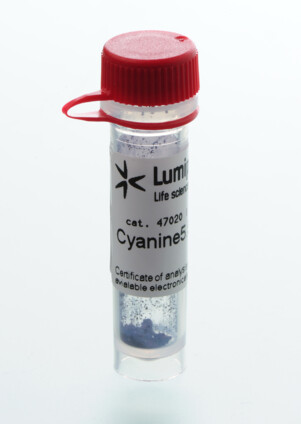Hexynoic acid NHS ester
| Cat. # | Quantity | Price | Lead time | Buy this product |
|---|---|---|---|---|
| 41720 | 25 mg |
$95
|
in stock | |
| 51720 | 50 mg |
$180
|
in stock | |
| 61720 | 100 mg |
$290
|
in stock | |
| 91720 | 1 g |
please inquire
|
in stock |

Hexynoic acid NHS ester is an alkyne-containing NHS ester for the modification of biomolecules. Alkyne groups for copper-catalyzed click chemistry reaction are nearly never encountered in natural molecules. However, this NHS ester allows to attach alkyne groups to amino groups, which are ubiquitous in nature, and which are present in proteins, peptides, synthetic amino-DNA and numerous small molecules. Alkyne groups can be subsequently modified and conjugated by copper-catalyzed click reaction.
This reagent is a derivative of hexynoic acid.
Customers also purchased with this product
General properties
| Appearance: | yellowish oil / off white crystals |
| Mass spec M+ increment: | 94.0 |
| Molecular weight: | 209.20 |
| CAS number: | 906564-59-8 |
| Molecular formula: | C10H11NO4 |
| IUPAC name: | 5-Hexynoic acid, 2,5-dioxo-1-pyrrolidinyl ester |
| Solubility: | good in organic solvents (DMF, DMSO, DCM) |
| Quality control: | NMR 1H 95+% |
| Storage conditions: | Storage: 12 months after receival at -20°C in the dark. Transportation: at room temperature for up to 3 weeks. Avoid prolonged exposure to light. Desiccate. |
| MSDS: | Download |
| Product specifications |
Product citations
- Monakhova, M. V.; Kubareva, E. A.; Kolesnikov, K. K.; Anashkin, V. A.; Kosaretskiy, E. M.; Zvereva, M. I.; Romanova, E. A.; Friedhoff, P.; Oretskaya, T. S.; Zatsepin, T. S. Reactive Acrylamide-Modified DNA Traps for Accurate Cross-Linking with Cysteine Residues in DNA–Protein Complexes Using Mismatch Repair Protein MutS as a Model. Molecules, 2022, 27(8), 2438. doi: 10.3390/molecules27082438
- Zanon, P.R.A.; Yu, F.; Musacchio, P.; Lewald, L.; Zollo, M.; Krauskopf, K.; Mrdović, D.; Raunft, P.; Maher, T.E.; Cigler, M.; Chang, C.; Lang, K.; Toste, F.D.; Nesvizhskii, A.I.; Hacker, S.M. Profiling the proteome-wide selectivity of diverse electrophiles. ChemRxiv, 2021, preprint. doi: 10.33774/chemrxiv-2021-w7rss-v2
- Kleinpenning, F.; Steigenberger, B.; Wu, W.; Heck, A.J.R. Fishing for newly synthesized proteins with phosphonate-handles. Nature Communications, 2020, 11, 3244. doi: 10.1038/s41467-020-17010-0

























 $
$ 
